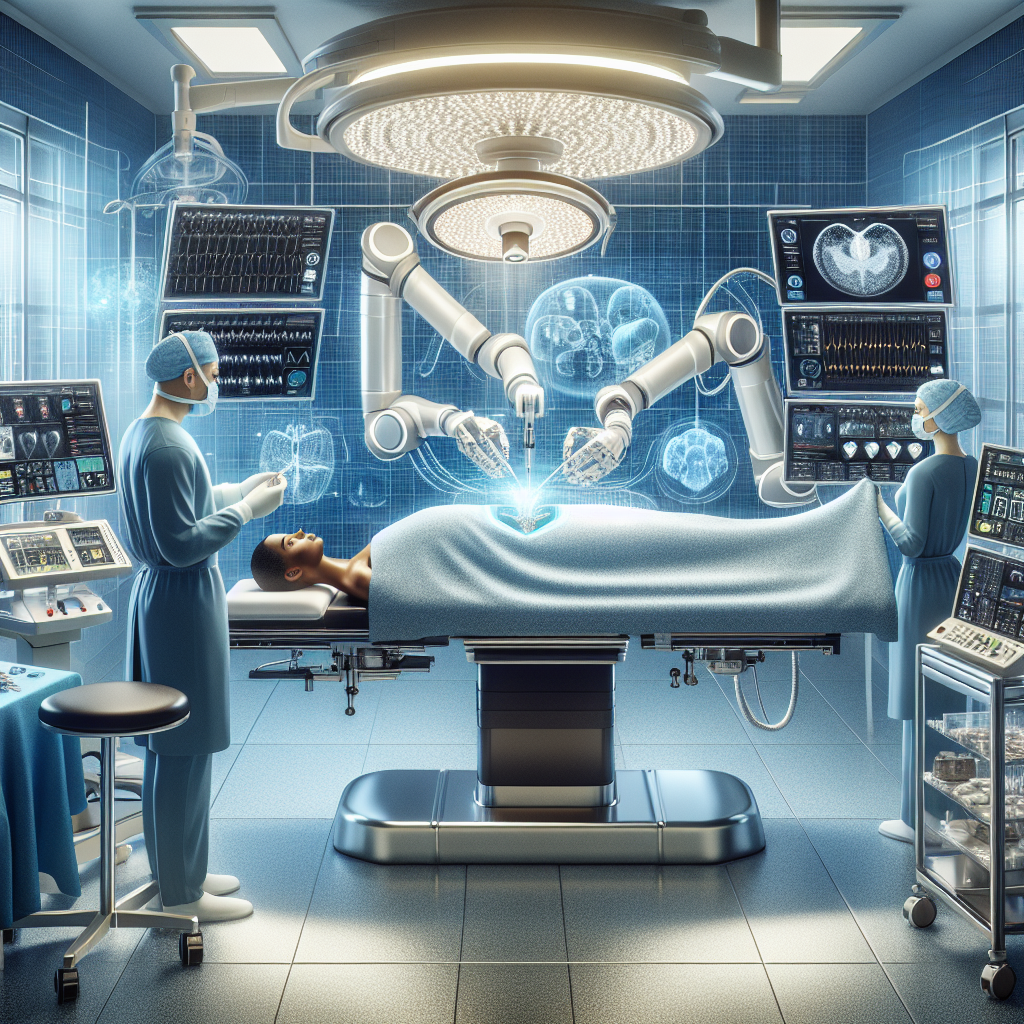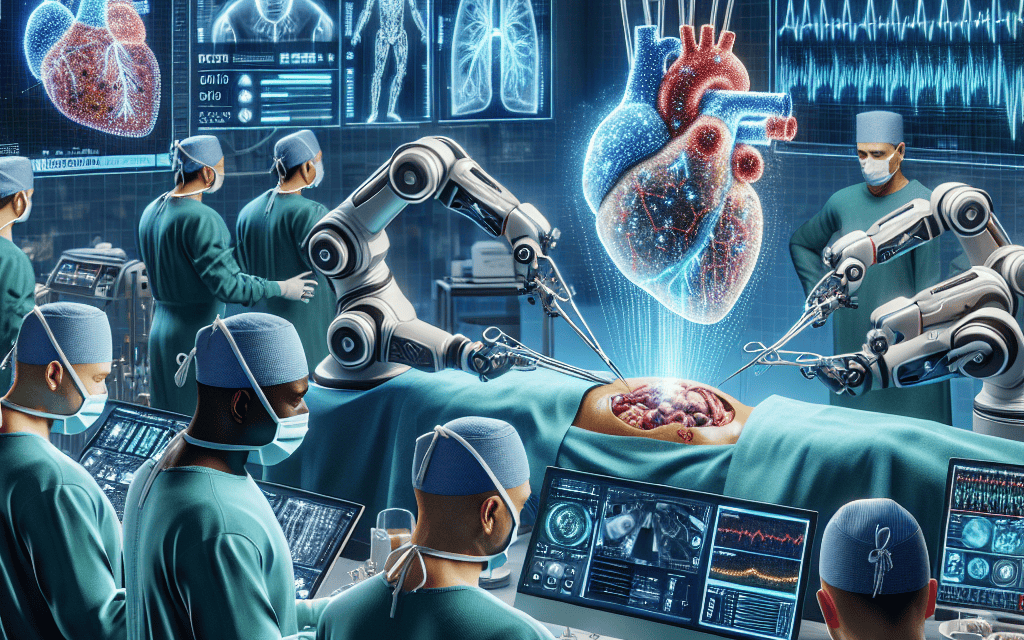Revolutionary Surgical Breakthroughs Driven by Artificial Intelligence

In recent years, the integration of artificial intelligence (AI) into the medical field has led to groundbreaking advancements, particularly in the realm of surgery. These technological innovations are not only enhancing the precision and efficiency of surgical procedures but are also transforming the way surgeons approach complex medical challenges. This article delves into the revolutionary surgical breakthroughs driven by AI, exploring various subtopics that highlight the profound impact of this technology on modern medicine.
1. AI-Powered Surgical Robotics
AI-powered surgical robotics represent one of the most significant advancements in the field of surgery. These sophisticated machines are designed to assist surgeons in performing intricate procedures with unparalleled precision and control. The integration of AI into surgical robotics has led to the development of systems that can analyze vast amounts of data, learn from previous surgeries, and adapt to the unique needs of each patient.
One of the most notable examples of AI-powered surgical robotics is the da Vinci Surgical System. This robotic platform allows surgeons to perform minimally invasive surgeries with enhanced dexterity and precision. The system’s AI algorithms assist in stabilizing instruments, reducing tremors, and providing real-time feedback to the surgeon. As a result, patients experience shorter recovery times, reduced pain, and fewer complications.
Another groundbreaking development is the use of AI in autonomous surgical robots. These robots are capable of performing certain tasks independently, such as suturing or tissue manipulation, under the supervision of a human surgeon. The Smart Tissue Autonomous Robot (STAR) is a prime example of this technology. STAR has demonstrated the ability to perform soft tissue surgeries with a level of precision that surpasses human capabilities, thanks to its advanced AI algorithms and imaging technologies.
The benefits of AI-powered surgical robotics extend beyond precision and efficiency. These systems also contribute to improved surgical outcomes by minimizing human error and enhancing decision-making processes. Surgeons can rely on AI to provide data-driven insights and recommendations, leading to more informed and effective surgical interventions.
- Enhanced precision and control in surgical procedures
- Minimally invasive surgeries with reduced recovery times
- Autonomous surgical robots capable of performing tasks independently
- Improved surgical outcomes through data-driven insights
2. AI in Preoperative Planning and Decision-Making
Preoperative planning is a critical component of successful surgical outcomes. AI has revolutionized this aspect of surgery by providing surgeons with advanced tools for analyzing patient data, predicting potential complications, and optimizing surgical strategies. The use of AI in preoperative planning has led to more personalized and effective treatment plans, ultimately improving patient outcomes.
One of the key applications of AI in preoperative planning is the analysis of medical imaging data. AI algorithms can process and interpret complex imaging data, such as CT scans and MRIs, with remarkable accuracy. This capability allows surgeons to identify anatomical structures, assess the extent of disease, and plan surgical approaches with greater precision. For instance, AI-powered imaging tools can help surgeons visualize tumors in three dimensions, enabling them to plan resections with minimal impact on surrounding healthy tissue.
AI is also being used to predict surgical risks and complications. By analyzing large datasets of patient information, AI algorithms can identify patterns and correlations that may indicate potential complications. This predictive capability allows surgeons to take proactive measures to mitigate risks and improve patient safety. For example, AI can help identify patients at higher risk of postoperative infections, enabling surgeons to implement targeted preventive measures.
Furthermore, AI is enhancing decision-making processes by providing surgeons with evidence-based recommendations. AI systems can analyze vast amounts of medical literature and clinical guidelines to offer insights into the most effective treatment options for specific conditions. This data-driven approach empowers surgeons to make informed decisions that align with the latest medical research and best practices.
- Advanced analysis of medical imaging data for precise surgical planning
- Prediction of surgical risks and complications
- Evidence-based recommendations for treatment options
- Personalized and effective preoperative planning
3. AI-Driven Intraoperative Guidance and Monitoring
During surgery, real-time guidance and monitoring are essential for ensuring optimal outcomes. AI has emerged as a powerful tool for providing surgeons with intraoperative support, enhancing their ability to navigate complex procedures and respond to dynamic situations. AI-driven intraoperative guidance and monitoring systems are transforming the surgical landscape by improving accuracy, reducing errors, and enhancing patient safety.
One of the primary applications of AI in intraoperative guidance is the use of augmented reality (AR) and virtual reality (VR) technologies. These technologies overlay digital information onto the surgical field, providing surgeons with real-time visualizations of critical structures and potential hazards. AI algorithms process imaging data to create detailed 3D models that guide surgeons during procedures. For example, AR systems can highlight blood vessels or nerves, helping surgeons avoid accidental damage and improve surgical precision.
AI is also being used to monitor vital signs and physiological parameters during surgery. Advanced AI algorithms can analyze data from sensors and medical devices to detect anomalies and alert surgeons to potential issues. This real-time monitoring capability allows for early intervention and reduces the risk of complications. For instance, AI can detect subtle changes in heart rate or blood pressure that may indicate an adverse reaction to anesthesia, enabling prompt corrective action.
Furthermore, AI-driven systems are enhancing surgical navigation by providing real-time feedback and recommendations. These systems can analyze data from various sources, such as imaging, sensors, and surgical instruments, to offer insights into the optimal path for surgical instruments. This guidance helps surgeons maintain accuracy and control, even in challenging or unfamiliar procedures.
- Augmented reality and virtual reality for real-time visualization
- Monitoring of vital signs and physiological parameters
- Real-time feedback and recommendations for surgical navigation
- Enhanced accuracy and control during complex procedures
4. AI in Postoperative Care and Rehabilitation
The role of AI in surgery extends beyond the operating room, with significant contributions to postoperative care and rehabilitation. AI-driven technologies are improving patient outcomes by facilitating personalized recovery plans, monitoring progress, and providing targeted interventions. These advancements are transforming the way patients recover from surgery, leading to faster healing and improved quality of life.
One of the key applications of AI in postoperative care is the development of personalized rehabilitation programs. AI algorithms can analyze patient data, such as medical history, surgical outcomes, and physical capabilities, to create tailored rehabilitation plans. These plans are designed to address the specific needs and goals of each patient, optimizing the recovery process. For example, AI can recommend specific exercises or therapies that target areas of weakness or limitation, promoting faster and more effective rehabilitation.
AI is also being used to monitor patient progress and detect potential complications during the recovery phase. Wearable devices equipped with AI algorithms can track vital signs, movement patterns, and other physiological parameters, providing real-time feedback to healthcare providers. This continuous monitoring allows for early detection of issues, such as infections or delayed healing, enabling timely interventions and reducing the risk of complications.
Furthermore, AI-driven virtual assistants and chatbots are enhancing patient engagement and support during the recovery process. These digital tools can provide patients with information, reminders, and guidance on postoperative care, helping them adhere to their recovery plans and make informed decisions. For instance, AI-powered chatbots can answer common questions about medication schedules, dietary restrictions, or wound care, reducing the burden on healthcare providers and improving patient satisfaction.
- Personalized rehabilitation programs for optimized recovery
- Continuous monitoring of patient progress and detection of complications
- AI-driven virtual assistants and chatbots for patient engagement
- Improved quality of life through targeted interventions
5. Ethical Considerations and Future Directions
While AI-driven surgical breakthroughs offer immense potential, they also raise important ethical considerations that must be addressed. As AI continues to play a more prominent role in surgery, it is crucial to ensure that these technologies are used responsibly and ethically. This section explores some of the key ethical challenges associated with AI in surgery and discusses potential future directions for this rapidly evolving field.
One of the primary ethical concerns is the issue of accountability and liability. As AI systems become more autonomous, determining responsibility for surgical outcomes becomes increasingly complex. It is essential to establish clear guidelines and regulations that define the roles and responsibilities of both human surgeons and AI systems. This includes addressing questions of liability in cases of errors or complications, as well as ensuring that AI systems are transparent and explainable.
Another ethical consideration is the potential for bias in AI algorithms. AI systems are trained on large datasets, and if these datasets are not representative of diverse populations, there is a risk of biased outcomes. It is crucial to ensure that AI algorithms are developed and validated using diverse and inclusive datasets to prevent disparities in surgical care. Additionally, ongoing monitoring and evaluation of AI systems are necessary to identify and mitigate any biases that may arise.
Privacy and data security are also significant ethical concerns in the context of AI-driven surgery. The use of AI requires access to vast amounts of patient data, raising questions about data protection and patient confidentiality. It is essential to implement robust security measures and adhere to strict data privacy regulations to safeguard patient information and maintain trust in AI technologies.
Looking to the future, the continued advancement of AI in surgery holds great promise for improving patient outcomes and transforming healthcare delivery. However, it is essential to approach these developments with caution and ensure that ethical considerations are at the forefront of innovation. Collaboration between healthcare professionals, technologists, ethicists, and policymakers will be crucial in shaping the future of AI-driven surgery and ensuring that these technologies are used for the benefit of all patients.
- Accountability and liability in AI-driven surgical outcomes
- Addressing bias in AI algorithms and ensuring diversity
- Privacy and data security in AI-driven surgery
- Collaboration for ethical and responsible AI innovation
Conclusion
The integration of artificial intelligence into the field of surgery is driving revolutionary breakthroughs that are transforming the way surgical procedures are performed and improving patient outcomes. From AI-powered surgical robotics to advanced preoperative planning, intraoperative guidance, and postoperative care, AI is enhancing precision, efficiency, and safety in surgery. However, as these technologies continue to evolve, it is essential to address ethical considerations and ensure that AI is used responsibly and equitably. By embracing the potential of AI while prioritizing ethical principles, the medical community can harness the power of this technology to revolutionize surgery and improve the lives of patients worldwide.





